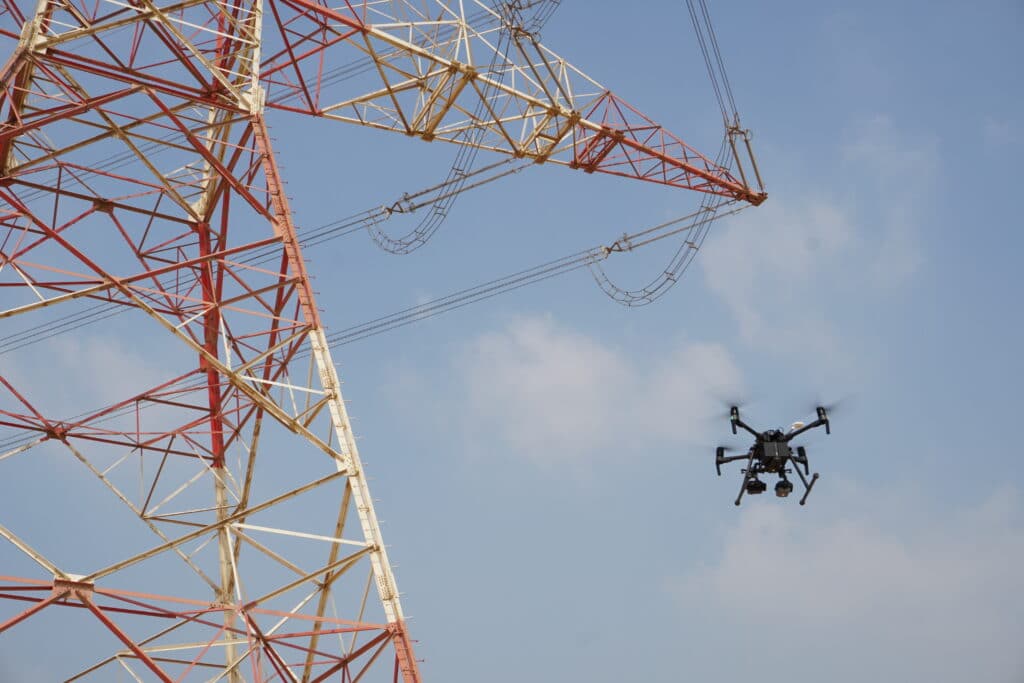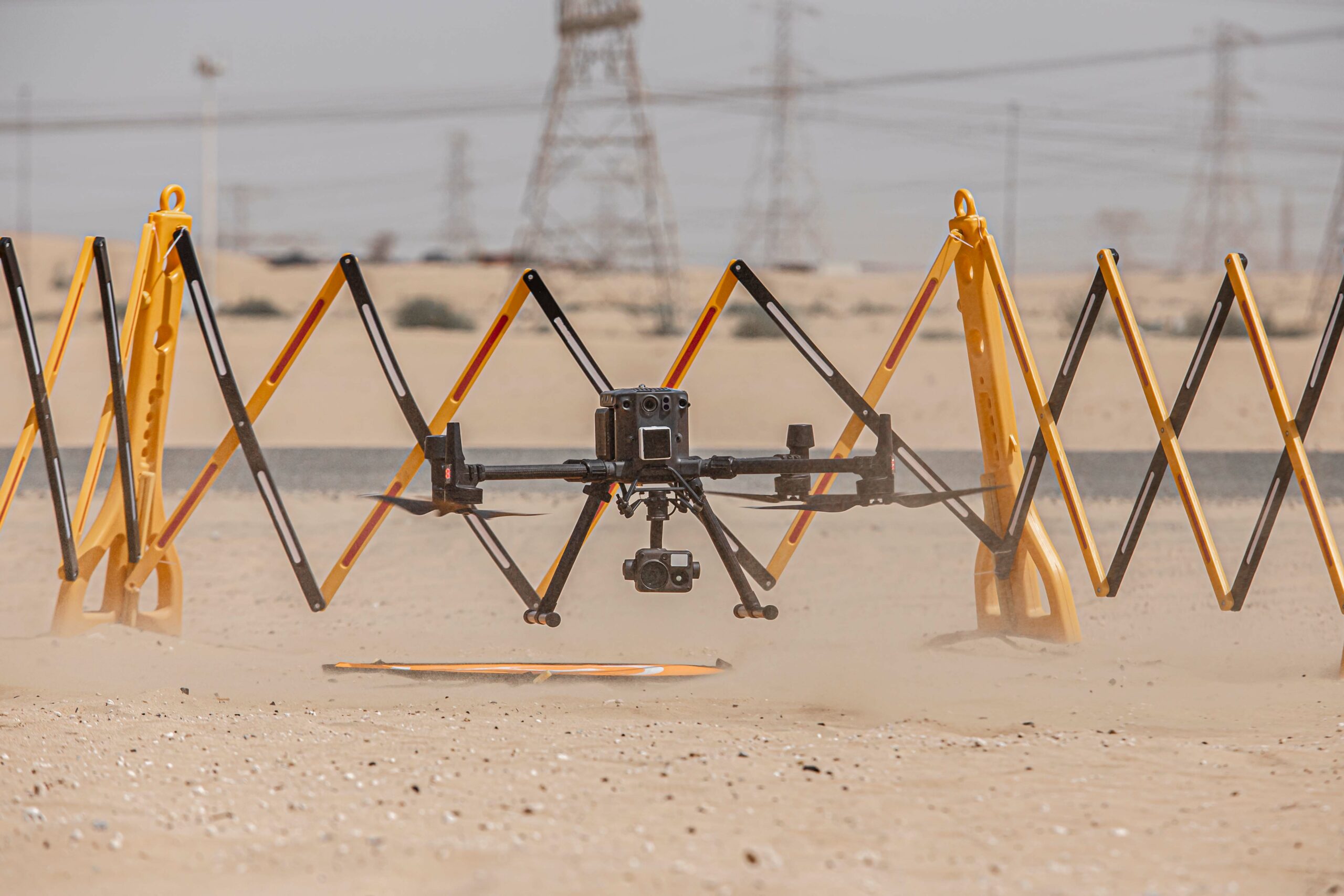
The drone powerline inspections roughly 10 times faster than the traditional ground-based inspections. Drones can cover large distances in just one flight. A single drone team can cover approximately 30 towers per day, whereas a ground team can cover approximately 3 towers per day. Powerful payloads like DJI’s Zenmuse H20T enable you to capture both visual and thermal data in just a single flight, which further improves inspection efficiency.
Drones are perfectly safe to fly close to live powerlines. Previously, you would have to shut down the line to make it safe enough for humans to get a closer look. Now, you can just send a drone and keep the line active and live while the inspections take place. This non-intrusive inspection method offers a tremendous reduction in downtime, allowing you to shut the line down only during maintenance operations.
Exposure hours are expensive. When you have an inspection team traversing through difficult terrain, climbing up to great heights, and working in close proximity to dangerous assets or tools— you have a lot of exposure hours. Using drones, you can isolate the inspectors from the hazards. While the drone navigates the hazards, humans can stay safe at a control point.

When compared on paper, ground teams may seem like the most cost-effective form of powerline inspection. But, to properly diagnose an issue, you may need to bring in specialised equipment or shut down the powerline. As the drone conducts inspections, it saves you money through reduced downtime, exposure hours, accidents as well as faster inspections.
Visual inspections are just one of the many applications. You have the Right of Way surveys, Vegetation Encroachment Detection, Corona Discharge Analysis, Thermal Inspections and more. If you require multiple outputs and still follow the traditional powerline inspection methods, you would have to purchase and maintain multiple tools and equipment. With drones, it’s a simple matter of swapping in the appropriate payload.
This question is extremely easy to answer. At least it was. Previously, it was DJI’s M300 RTK— hands down. We even have videos swearing by it; and for good reason! However, with the recent introduction of the M30 series, this decision is now split between the two.
Drone Powerline Inspections with DJI M30
The M30 makes this decision difficult by being as good as or, in certain situations, better than the M300 RTK. Suffering from just a slightly depreciated flight time and non-swappable payloads, the M30 excels in other matters. For example, it is more durable than the M300 RTK, the M30 is IP55 rated, it is more compact; and boasts better image resolution.
In regions where rain is frequent, the M30 is a clear winner. The drone can fly into water jets coming at it from all angles, allowing you to continue your operations while braving the weather.
Let’s talk about the reduced flight time. When the FEDS team performs inspections, they spend, on average, about 15 minutes per tower. This makes the 41 minute flight time more than sufficient for powerline inspections. Besides, the compact form factor allows you to fit more drones and batteries in your car or truck.
Specific to powerline inspections, the M30 T is required for its thermal capabilities. Something exciting to look forward to is the DJI Dock. We anticipate that as drone technology grows closer to complete autonomy, this dock is a major key to that puzzle. In the future, you probably won’t even have to step out of the office. But, for now, you can set up an M30T with its dock at truly remote substations and powerlines or ones that require more frequent monitoring and save yourself some trouble.

Drone Powerline Inspections with DJI M300 RTK
The current undisputed “best” for powerline inspections is, of course, the DJI M300 RTK. To be transparent, this drone is the inspiration for this article. When comparing with traditional methods or analysing data to determine the benefits, the M300 was used as the benchmark. The incredible durability of the M300 inspires confidence. It allows you to fly extremely close to live powerlines and capture effective data.
Prior to the M300, we found that electro-magnetic interference (EMIs) posed a significant challenge to drone flights. The EMIs forced us to fly further away from the powerlines to be safer which made the data less valuable. The DJI M300 RTK’s build quality and host of intelligent features are a tremendous boon to inspectors and boost their safety and efficiency. Using the M300, the FEDS team can inspect an average of 30 towers per day!
If your approach is more of a ‘be-all and end-all’ approach, the M300 RTK is the drone for you. With its three payload configurations and a multitude of compatible payload options, the M300 empowers you with unbelievable accuracy, efficiency, reliability and all the outputs you could ever need.
Drone powerline inspections bring with them a plethora of benefits that the traditional methods lack. Drones revolutionise inspection operations with their astounding efficiency and safety boosts, and the data they provide leads to better fault detection and ease of processing and integrating. If you’d like a cost-free demo of how drones can improve your inspection operations; feel free to get in touch with us.